Custom Workstation For 3d Design
The most interesting thing about looking for a Computer or Workstation for 3D Modeling and Rendering is the fact that 3D Modeling and (CPU) Rendering are two very different use cases.
Each of them uses the Hardware of a Computer in very different ways!
Before we dive into it, take a quick look at the Table of contents here, in case you prefer to skip the theory and want to know my recommendations immediately:
Also, be sure to drop by our Forum full of PC Enthusiasts and Experts if you should have any questions!
CPU Rendering
CPU Rendering uses all cores of your CPU, 100% of the time while rendering.
This means, if you'll use your Workstation just for 3D Rendering Images and Animations, or encoding Videos for that matter, you would be looking for a Computer with a CPU, that has as many cores as possible.
Even if these cores are clocked relatively low.
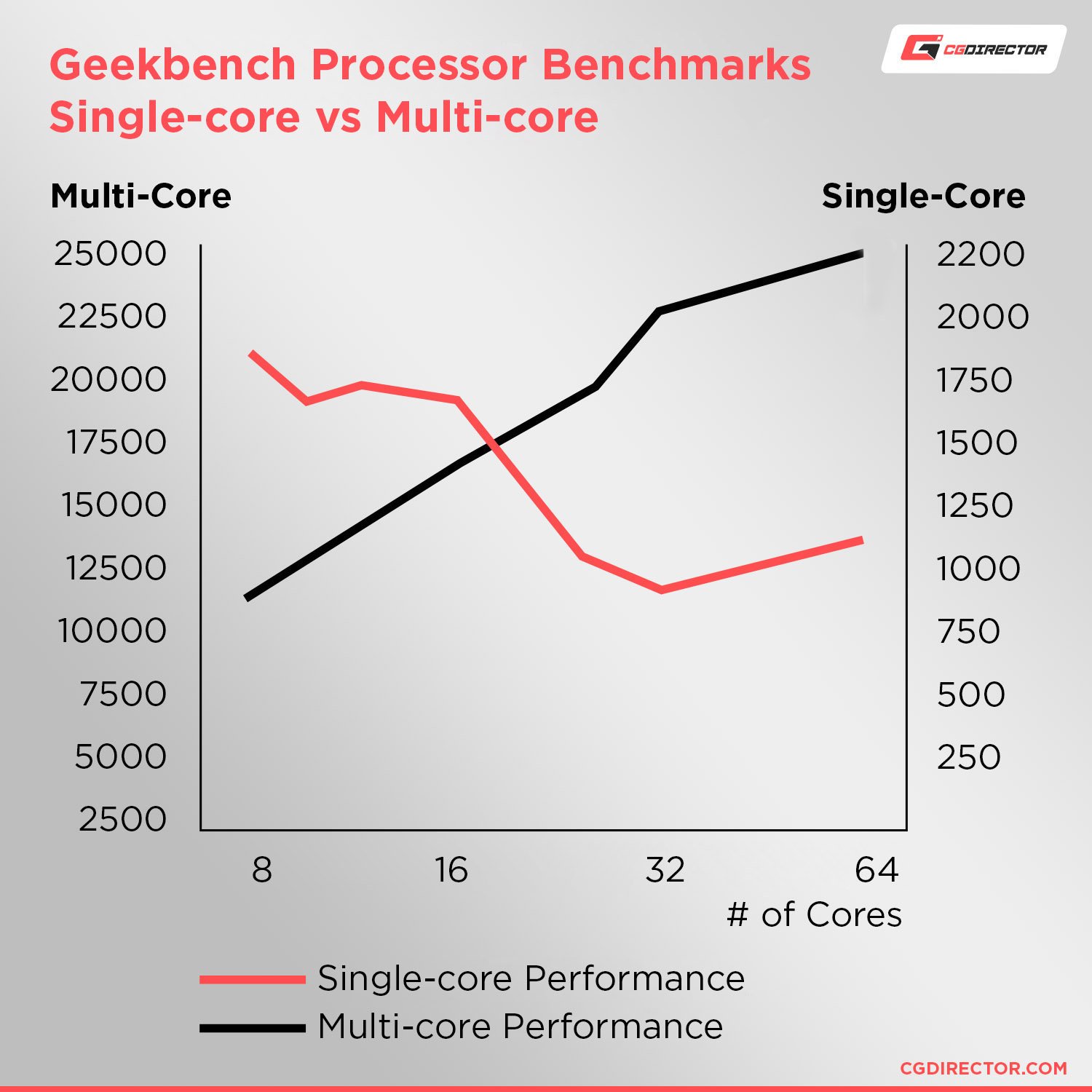
This is because the render engine assigns a so-called "bucket" to each core in your CPU. Each individual core will render its bucket and then get a new bucket once it's finished rendering the old one.
Perfect for Multi-Core CPUs.
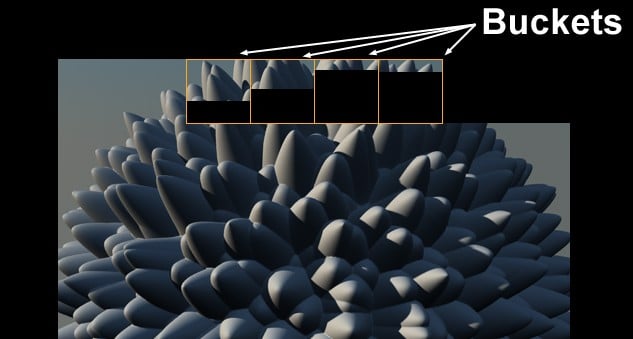
3D Modeling
Contrary to rendering, 3D modeling is an active working process .
You (usually) sit in front of your computer and interact with the 3D Application.
Actively using Software utilizes the Hardware it is running on in entirely different ways.
Take this example: I am modeling a car. That Car consists of Polygons that will have modifiers and Deformers applied to it, such as Mirroring, Cloning, Bending Objects, and so on.
Your computer has to go through some serious calculations to process all this, but the key here is that these calculations are mainly done on only a SINGLE CPU Core.
Why? Because the Scene is built according to a certain hierarchy. A CPU has to work its way through this hierarchy step by step.
It can't skip or off-load certain steps to other cores, because most of the steps depend on each other!

What does this mean?
It means quite frankly that having lots of CPU-Cores will do nothing towards speeding up your modeling and does not usually make your Viewport faster.
Long explanation short:
For Modeling and actively working in your 3D Scene, you would need to get a CPU that has the highest Clock Speed possible.
It doesn't matter if it only has a few Cores, as most of these Cores won't be used for modeling.
Take a look at this page to find the highest clocking CPUs currently available.
Same is also valid for working on Computer Animations or for running a CAD Workstation. A high-Clocking CPU will almost always outperform a high-Core-count CPU.
If you had to pick one: Which do you consider your main 3D Software?
-
Blender 39%, 13037 votes
13037 votes 39%
13037 votes - 39% of all votes
-
3ds Max 19%, 6168 votes
6168 votes 19%
6168 votes - 19% of all votes
-
Maya 13%, 4256 votes
4256 votes 13%
4256 votes - 13% of all votes
-
Cinema 4D 12%, 4089 votes
4089 votes 12%
4089 votes - 12% of all votes
-
Revit 5%, 1774 votes
1774 votes 5%
1774 votes - 5% of all votes
-
Zbrush 5%, 1656 votes
1656 votes 5%
1656 votes - 5% of all votes
-
Other 4%, 1243 votes
1243 votes 4%
1243 votes - 4% of all votes
-
Houdini 2%, 798 votes
798 votes 2%
798 votes - 2% of all votes
-
Modo 1%, 169 votes
169 votes 1%
169 votes - 1% of all votes
-
Artlantis 0%, 91 vote
91 vote
91 vote - 0% of all votes
-
Katana 0%, 45 votes
45 votes
45 votes - 0% of all votes
Total Votes: 33326
14. May, 2020
×
You or your IP had already vote.
The more Cores and the higher the clock speed, the better, right?
It's now tempting to think you should get a CPU with lots of cores AND high clock speeds . After all, then we'll have a workstation on which we can work fast AND which can render fast, right?
Unfortunately, because of power consumption and heat limits, there usually is a proportional trade-off between the number of CPU-cores and clock-speeds.
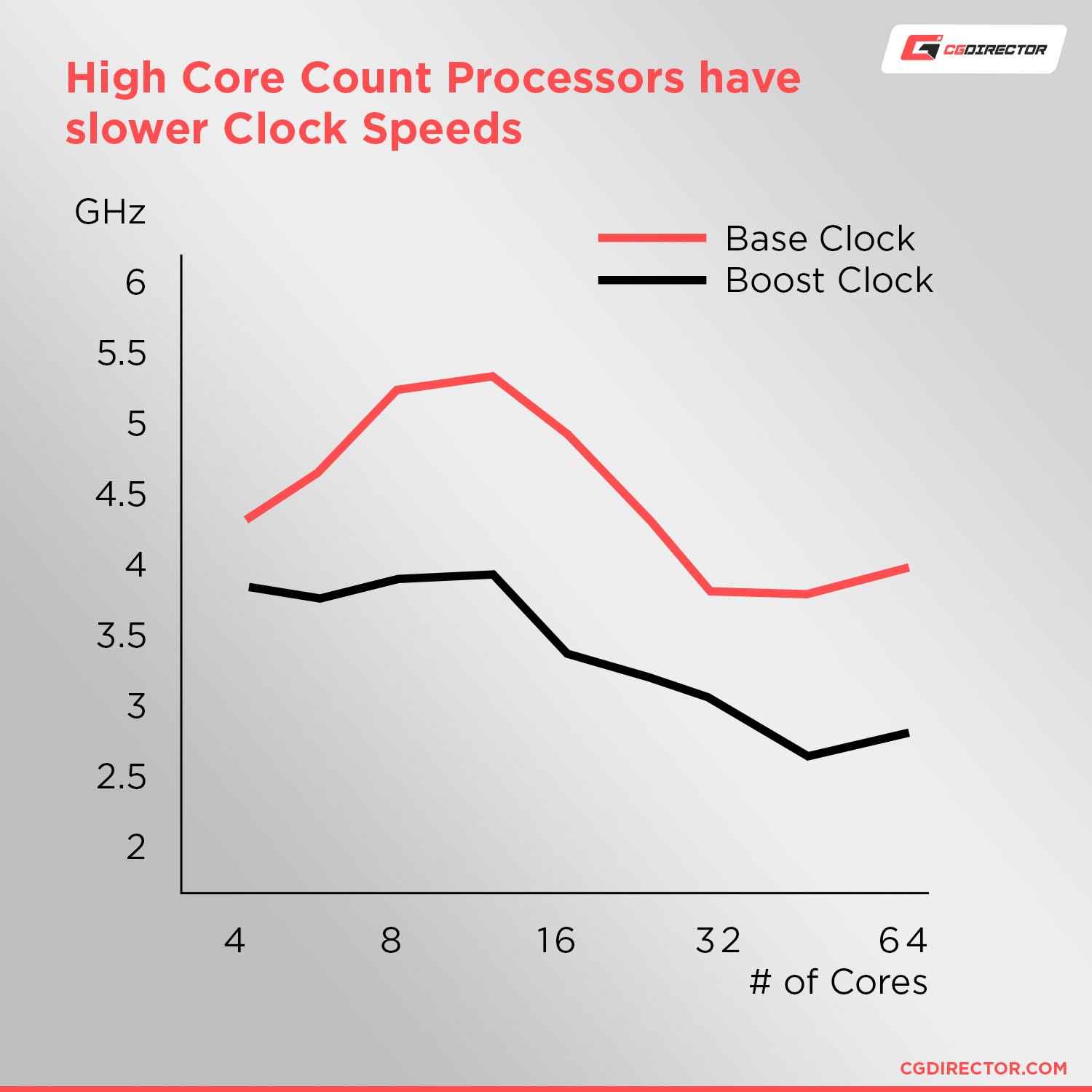
This means the more Cores the CPU has, the lower it will usually clock and vice versa.
The faster the Cores are clocked, the fewer cores there usually are on the CPU.
Many Cores need lots of Power and lots of Power produces lots of heat. CPUs have thermal regulations that need to be adhered to. The same applies to higher clocked cores that will be hotter than lower clocked cores.
This is quite a bummer, but the major CPU Manufacturers wouldn't be all that major if they hadn't found a way to improve upon this.
AMD and Intel have thought of a nice way of compensating for some of these trade-offs.
Enter Turbo-Boost.
Turbo-Boost (Turbo-Core)
Turbo-Boost is a feature that automatically overclocks Cores until thermal and power limits are reached. Depending on the Quality of cooling, the duration can vary.
Say we are currently modeling and are only really using 1-2 Cores, the rest of the Cores are idle.
What Turbo boost does now is overclock these 1-2 Cores as far as specified by the manufacturer and as long as the Power Consumption and Temperature stays within the predefined limit.
As soon as these limits are reached, the Turbo-Boost will clock these two cores back down.
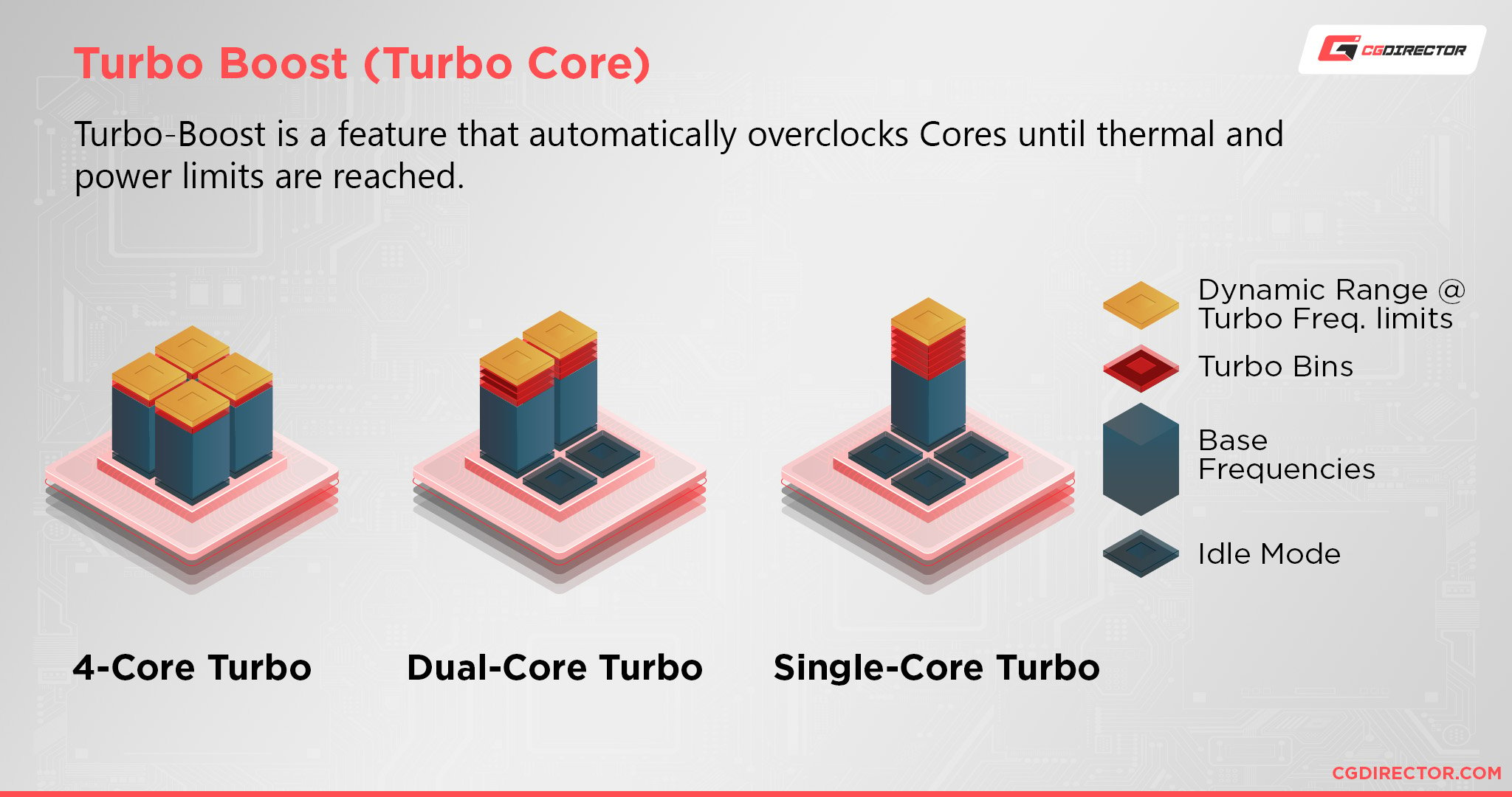
Cores can be overclocked with available temperature and power headroom
This way, to a certain degree, we can get CPUs with more Cores (and a low base-clock), that clock higher on limited cores, when needed and not all cores are being used.
CPU vs GPU Rendering
There are currently two popular methods of Rendering Images and Animations in 3D Software:CPU Rendering and GPU Rendering.
Are you mainly rendering on the GPU or CPU?
-
Mainly GPU 60%, 10295 votes
10295 votes 60%
10295 votes - 60% of all votes
-
Mainly CPU 40%, 6735 votes
6735 votes 40%
6735 votes - 40% of all votes
Total Votes: 17030
14. May, 2020
×
You or your IP had already vote.
As you probably guessed, CPU Rendering utilizes the Processor for calculating the Image, and GPU Rendering utilizes the Graphics Card.
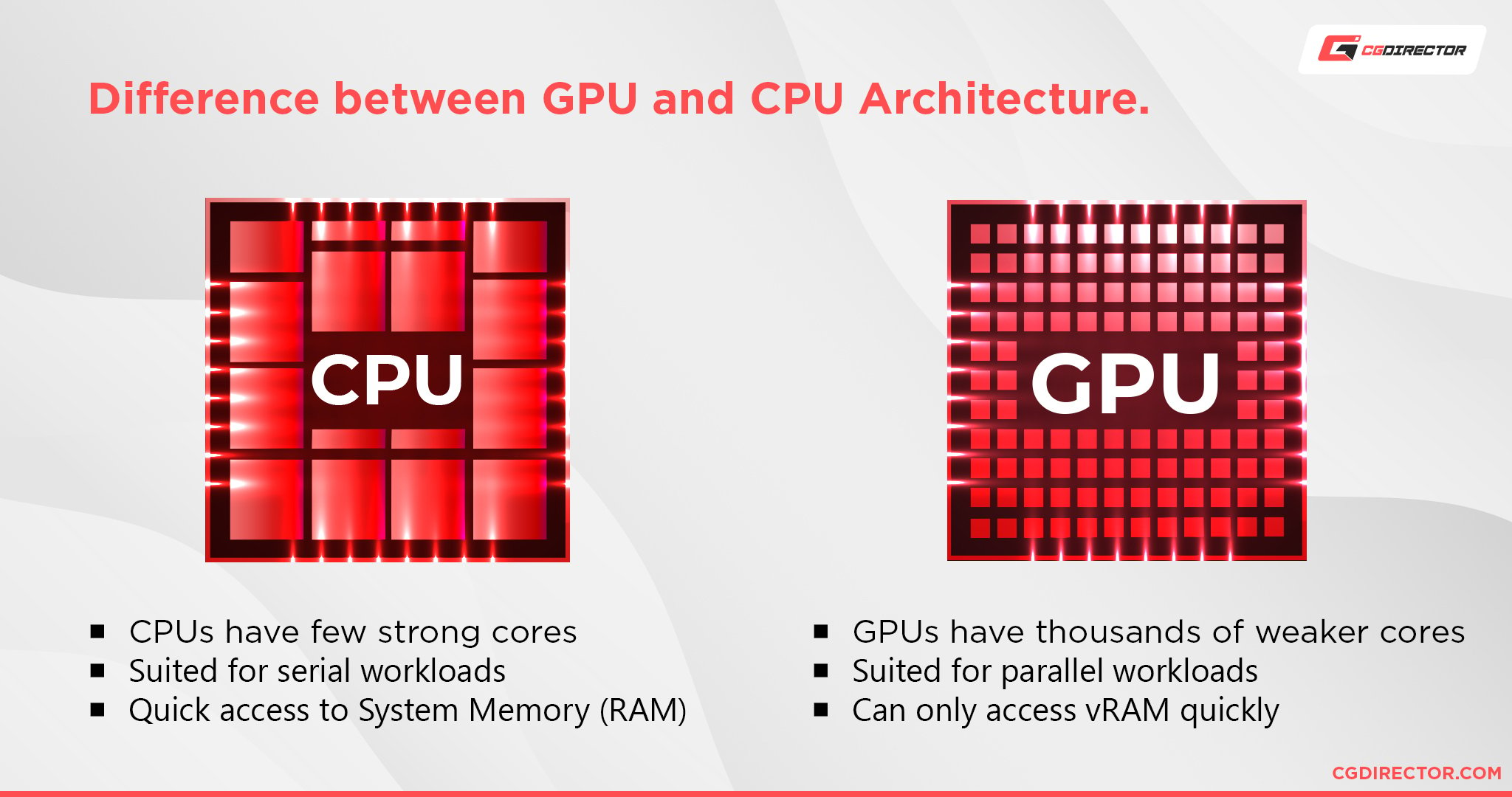
There are some differences in GPU and CPU rendering that you want to be aware of when choosing a new Computer or Workstation for 3D Rendering and Modeling:
First of all, almost every popular 3D Software comes with an inbuilt CPU Render Engine nowadays.
Only recently have GPU Render Engines such as Octane, Redshift, V-RAY RT, or FurryBall become mature enough to slowly but surely overtake CPU Render Engines in popularity.
Especially, because GPU Render Engines are much faster in many cases and allow for extremely interactive preview Renderers. Changing to a GPU Render Engine is one of the top methods in achieving faster renders – given your GPU is strong enough and has a sufficient amount of VRAM.
This can improve and accelerate a 3D-Artists Workflow tenfold as you are able to iterate more often before finishing a project.

Image-Source: furryball.aaa-studio.eu
Beginners are often told to start with 3D Rendering on the CPU and later switch to (often) costly 3rd Party GPU Render Engines when they have learned enough to properly utilize them.
I think this is about to change.
Just look at Blender's in-built Cycles GPU Render Engine and Cinema 4Ds new ProRender GPU Render Engine. Both GPU render engines are built into the software itself and don't rely on third-party plugins.
If you had to pick one: Which do you consider your main Render Engine?
-
V-Ray 34%, 5971 vote
5971 vote 34%
5971 vote - 34% of all votes
-
Cycles 25%, 4520 votes
4520 votes 25%
4520 votes - 25% of all votes
-
Arnold 11%, 1991 vote
1991 vote 11%
1991 vote - 11% of all votes
-
Octane 8%, 1505 votes
1505 votes 8%
1505 votes - 8% of all votes
-
Redshift 7%, 1285 votes
1285 votes 7%
1285 votes - 7% of all votes
-
Corona 6%, 1151 vote
1151 vote 6%
1151 vote - 6% of all votes
-
Other 5%, 945 votes
945 votes 5%
945 votes - 5% of all votes
-
Mental Ray 2%, 288 votes
288 votes 2%
288 votes - 2% of all votes
-
Maxwell 1%, 162 votes
162 votes 1%
162 votes - 1% of all votes
Total Votes: 17818
14. May, 2020
×
You or your IP had already vote.
Best individual Hardware Parts for 3D Modeling and Rendering explained
But enough talk! Let's take a look at what specific Computer Parts you'll need for the best Computer or Workstation for 3D Modeling and Rendering:
Best Processor (CPU) for 3D Modeling and Rendering
For Active Work: Intel i9 10900K or AMD Ryzen 9 5950X
As explained above, you'll have to make a decision depending on what you will use your computer most for.
Do you use it mainly to Model, Sculpt, Texture, Light, Animate and you spend much more time actively on it, than rendering on it?
Then you'll want a CPU that is clocked as high as possible!
Good choices here are (higher up in the list is better):
- AMD Ryzen 9 5950X, 16-Cores, Clocked at 3,4 GHz Base, 4,9 GHz TurboBoost (Turbo Core)
- AMD Ryzen 9 5900X, 12-Cores, Clocked at 3,7 GHz Base, 4,8 GHz TurboBoost (Turbo Core)
- Intel i9 10900K, 10-Cores, Clocked at 3,7 GHz Base, 5,3 GHz TurboBoost
- Intel i7 10700K, 8-Cores, Clocked at 3,8 GHz Base, 5,1 GHz TurboBoost
- AMD Ryzen 9 3950X, 16-Cores, Clocked at 3,5 GHz Base, 4,7 GHz TurboBoost (Turbo Core)
- AMD Ryzen 9 3900X, 12-Cores, Clocked at 3,8 GHz Base, 4,6 GHz TurboBoost (Turbo Core)
- AMD Ryzen 7 3700X, 8-Cores, Clocked at 3,6 GHz Base, 4,4 GHz TurboBoost (Turbo Core)

Image-Source: AMD/Intel
A great benchmark for finding CPUs that are the snappiest is the Cinebench Single-Core Benchmark.
Take a look at this page with Cinebench R23 Benchmarks and sort the Table on the "Cinebench Single" columnto find the CPU that will give your workstation the best performance when you're actively working on it.
What CPU Core-Feature is more valuable / important to you?
-
Having High Core-Clocks for fast active work (e.g. i9 10900K) 56%, 3395 votes
3395 votes 56%
3395 votes - 56% of all votes
-
Having a lot of Cores for fast Multi-Processing (e.g. TR 3990X) 44%, 2708 votes
2708 votes 44%
2708 votes - 44% of all votes
Total Votes: 6103
14. May, 2020
×
You or your IP had already vote.
If you have the budget for an AMD Ryzen 9 5950X, this CPU is currently the best CPU for active Work such as Modeling and Animation. It also sports 16 Cores which gives you nice multi-core rendering performance.
Texturing 3D Models and painting or sculpting, too, need a high-clocking CPU. If you consider yourself a Graphic Designer and do less Rendering, the AMD Ryzen 9 5900X is an excellent choice.
For Render Work? AMD Threadripper CPUs such as the Threadripper 3960X!
Do you use this Workstation less for active work and more to Render out your Projects? Do you spend more time on Rendering than on actually sitting in front of it?
You should consider going into a high core-count direction which are the best CPUs for Rendering (Or if you want a second Computer just for Rendering on).
Good choices here are:
- AMD Threadripper 3960X, 3970X, 3990X – 24-64 Cores – Highly Recommended!
- Intel i9 10900X, 10920X, 10960X, 10980XE – 10-18 Cores (quite expensive)
If you want to use VRAY, as it is one of the most popular Render Engines available, have a look at the following page to get an overview of the VRAY CPU Benchmarks Results.

The 3990X inside our Review System
Because Rendering demands can be quite high, and a single PC might not be enough to crunch through all of your frames in a short time, be sure to check our Guide on building your own Render Farm.
Which CPU are you planning on Buying?
-
AMD Ryzen (e.g. 2700X, 3700X, 3900X...) 60%, 4477 votes
4477 votes 60%
4477 votes - 60% of all votes
-
Intel LGA 1151 Series CPU (e.g. i7 8700K, i9 9900K...) 19%, 1425 votes
1425 votes 19%
1425 votes - 19% of all votes
-
AMD Threadripper (e.g. 2950X, 3960X...) 16%, 1192 votes
1192 votes 16%
1192 votes - 16% of all votes
-
Intel 2066 (HEDT) X-Series CPU (e.g. i9 10980XE...) 4%, 329 votes
329 votes 4%
329 votes - 4% of all votes
Total Votes: 7423
14. May, 2020
×
You or your IP had already vote.
Best Graphics Card (GPU) for 3D Modeling and Rendering
Best GPU for GPU Rendering: GPU Rendering is becoming more popular as we speak and is likely to overtake CPU Rendering in the near future.
Some of the most popular modern GPU Render Engines are Octane, Redshift, VRAY-RT, and Cycles. The first two only support NVIDIA GPUs, while the latter also supports AMD (OpenCL) GPUs.
Personally, I prefer recommending GPUs that work with any of the above Render Engines (CUDA Support), so here are a few NVIDIA GPUs in order of Performance that will give you excellent GPU Rendering Speed:
- NVIDIA RTX 3090
- NVIDIA RTX 3080
- NVIDIA RTX 3070
- NVIDIA RTX 3060 Ti
- NVIDIA RTX 2070 Super
- NVIDIA RTX 2060 Super
- NVIDIA GTX 1660 Super
This Nvidia List could go on, but I think you get the gist.
The higher the number, the faster and the more expensive they get.
Here is a GPU Render Benchmark overview if you'd like to compare the cost to performance in a bit more detail.
Other great GPU Benchmarks to take a look at are the VRAY-RT, Octane, and Redshift benchmarks.
In more Detail: Why no AMD GPUs (yet)?
The question of why we are not recommending AMD GPUs at this time is certainly warranted.
While you can certainly do most of the 3D work with a Radeon RX 6800XT or a similar AMD GPU Model, NVIDIA GPUs just have much wider support in GPU Render Engines and tend to perform better in many content creation workloads.
While there might be some Engines that support AMD's GPUs, all of them support NVIDIA GPUs. If you want to be able to jump into different Apps and Engines without compatibility concerns, going with Nvidia is currently the better decision.
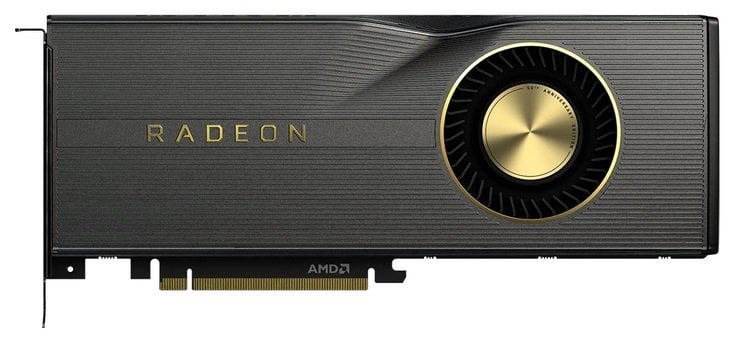
Image-Credit: AMD
This might just be temporary though, as many Render Engine Developers (Redshift, Octane, and more) have announced to work on implementing support for AMD GPUs.
Of course, if you know exactly that you will be using ProRender or other Engines with AMD GPU Support, go for it! AMD's offerings have great value.
Best GPU for Viewport performance
As the Processoris usually the bottleneck in having a snappy Viewport, Graphics Cards shouldn't usually make a noticeable difference, if you buy good enough.
All the GPUs listed above will perform roughly the same in Viewport performance.
This is because there are rarely features in 3D Applications, that the GPU computes slower than it takes the CPU to update Meshes, Deformers and the like.
In other words: The GPU usually has to wait for the CPU to finish its tasks to continue working.
This being said, if you rely heavily on In-Viewport SSAO, Reflections, AO, Anti-Aliasing, and the like, you might want to lean towards the top of the above GPU list for a snappy Viewport.
But for most, a high clocked-CPU will make a much larger difference.
Let's pick the Nvidia RTX 2070 for our Best Computer for 3D Modeling and Rendering, as it has excellent GPU-Render value and is fast enough for any kind of Viewport challenges.
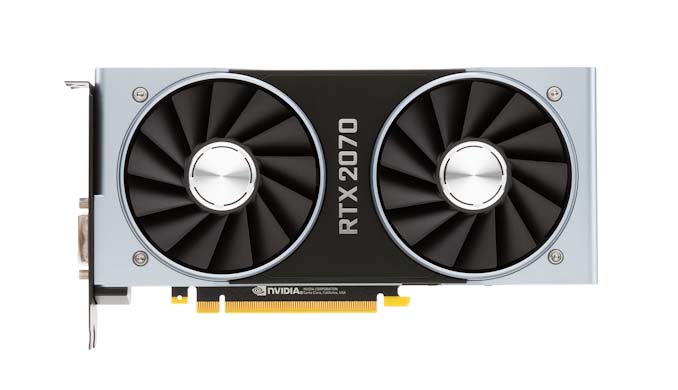
Image-Source: Nvidia
A quick heads-up:
In rare cases, if you only use a few extremely high-poly RAW meshes (such as a CAD-Converted Car with 40 Million Polygons) and you don't have any modifiers on this mesh, then the GPU will probably be the bottleneck as your workstation only has to update the viewing angle of the Car and not the meshes underlying structure.
Do take a look at our Viewport-Performance Benchmark and top-performing CPUs here.
How much and what type of RAM (Memory) do you need for 3D Modeling and Rendering?
Similar to the CPU, the amount and type of memory (RAM) you'll need will depend on your use case.
If you work on models with extremely high polygon counts, you will want more RAM than if you usually only do lightweight 3D work with simpler scenes.
I recommend 32GB of RAM for most 3D Artists.
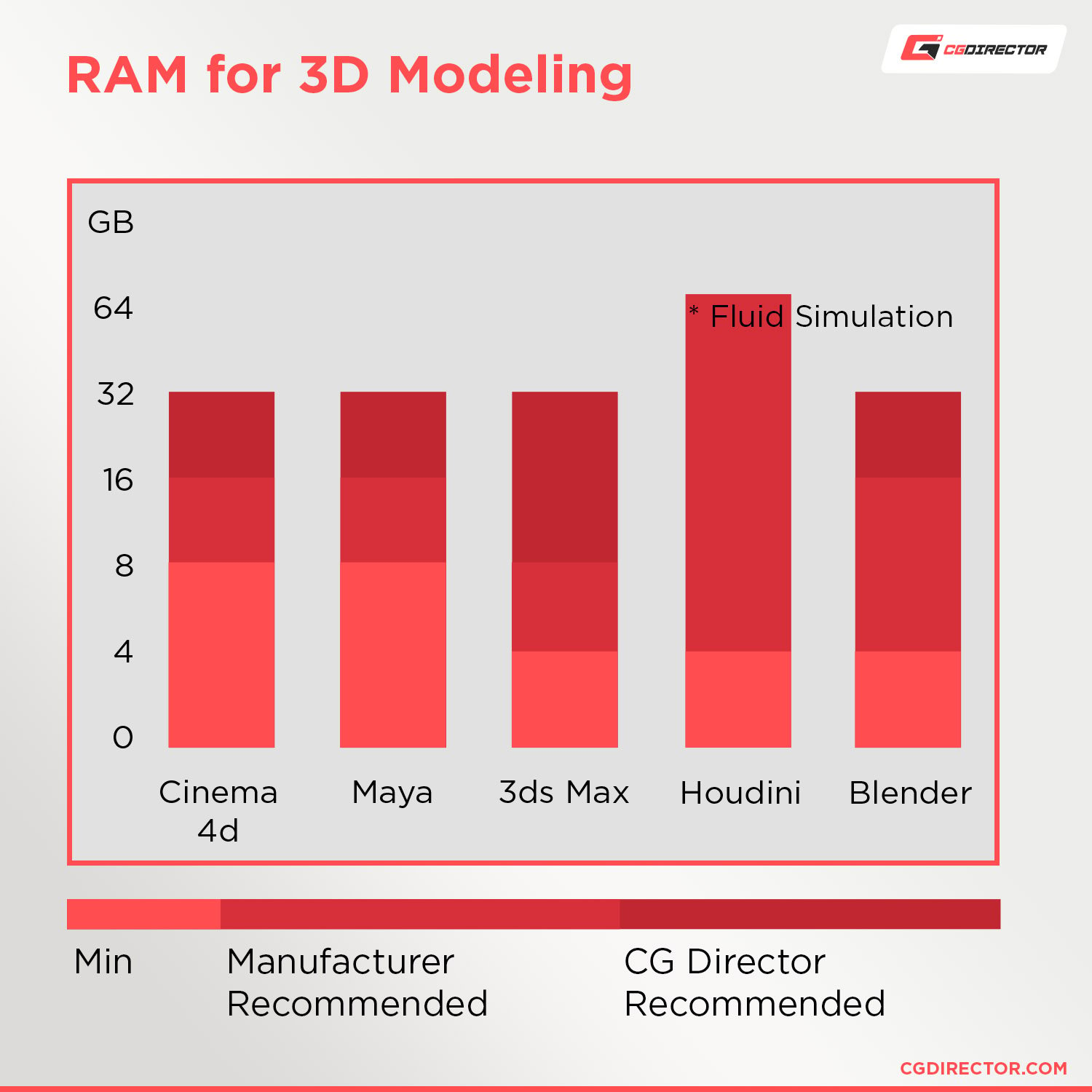
If you sculpt or work on high-poly meshes, use lots of large textures or have complex scenes with thousands of objects in them, you might want to go with 64GB of RAM.
16 GB of RAM can be enough for many starting out with 3D, but usually, you outgrow this quite quickly.
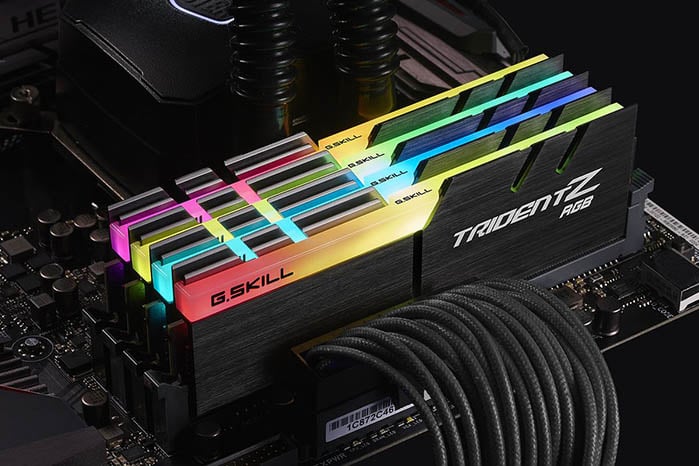
Image-Source: gskill
RAM speeds & timing can normally be ignored, as these don't make much of a difference performance-wise.
Getting DDR4-4166 RAM won't be noticeably faster than DDR4-2666 RAM.
So having Quad Channel Memory that is clocked at 2933Mhz might give you a slightly higher performance on Threadripper CPUs.
If you do like to optimize your hardware as much as possible, the rule is usually:
The lower the CL and the higher the Clock Speed, the better. So a DDR4-3200 CL15 would be slightly faster than a DDR4-2800 CL16 for example.
The 3rd and 4th gen (5xxx series) AMD Ryzen CPUs too, benefit from higher clocked RAM.
A note on RAM Kits
When buying RAM, buy the full amount in a single RAM kit. RAM Kits (which are RAM Modules packaged together) are pre-tested in the Factory and will work well together.
Although people often say you can buy some RAM now and add some more later,RAM modules sometimes don't work well together.
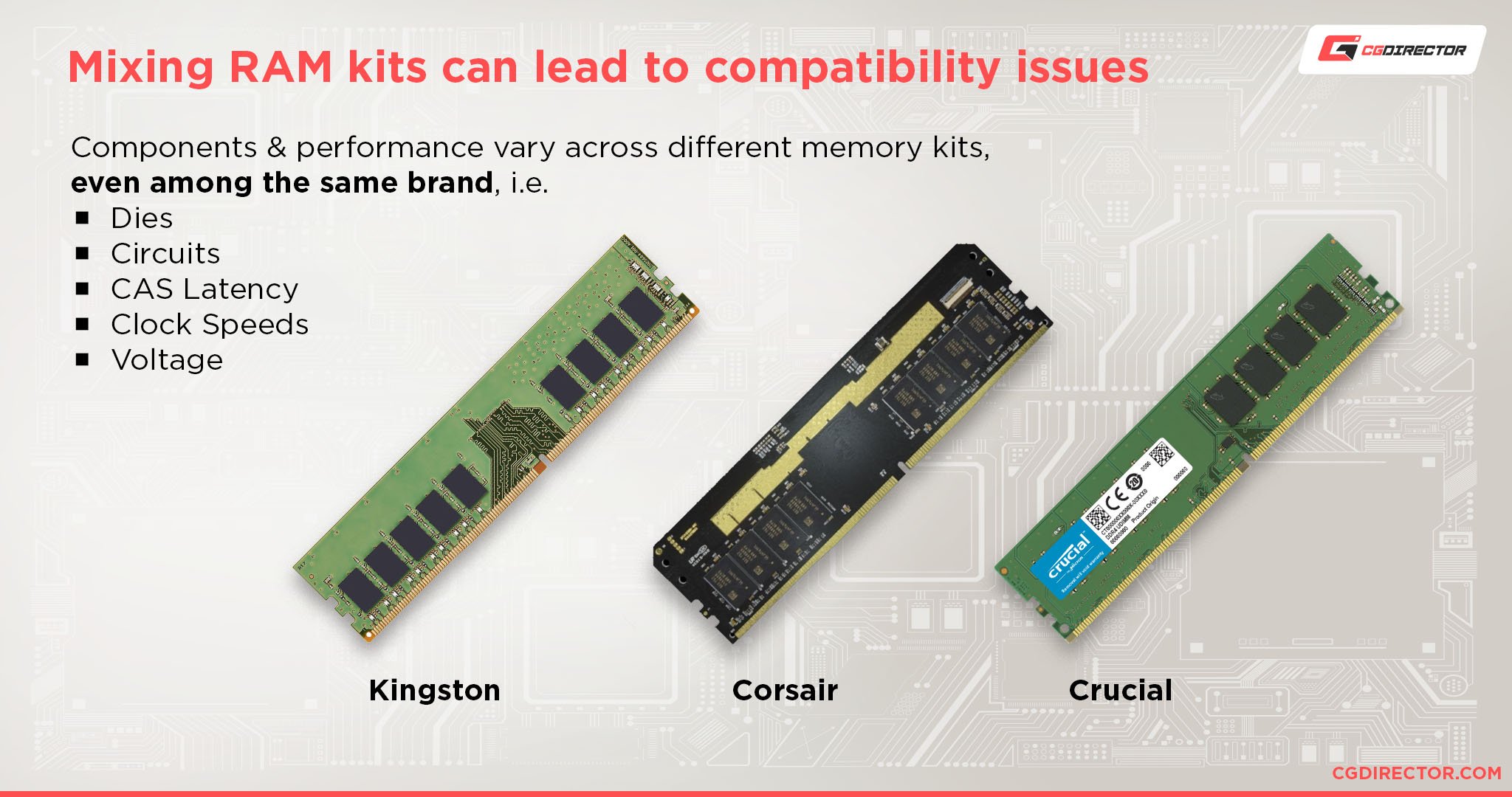
So if you are getting entirely new RAM for your PC, be sure to get (for example) 4x8GB in a KIT and not 2x8GB + 2x8GB in two separate KITs.
Why should RAM in different KITs be different from each other?
The reason why RAM in different kits differ from each other is because they can be manufactured in different factories and different factory lines that use slightly different silicon, or because one RAM module might have been manufactured in 2017, while the other module was manufactured in 2019. You don't know for sure that the timing on the RAM will be exactly the same between modules from different factories or different manufacturing dates.
My point is: get a kit that's pre-tested.
Good RAM Brands are G.Skill, ADATA, Crucial, and Corsair such as the Corsair 16GB Vengeance LPX Ram Kit or this 32GB Corsair RAM Kit.
Best Motherboard for 3D Modeling and Rendering
The Motherboard or Mainboard is the Hub that connects all of your hardware components together.
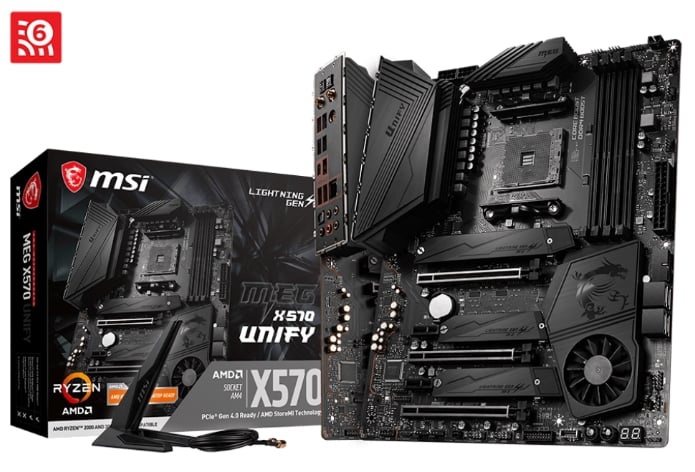
Image-Credit: MSI
It's unlikely to impact performance all that much, but you should make sure it has all the features you need. Some important things to take note of are:
- CPU Socket Type: Different CPUs need different Sockets. Make sure your motherboard has the right socket for your CPU.
- Memory Maximum: Some Motherboards/Chipsets can only support a certain amount of RAM and only have a certain number of RAM slots. Make sure it supports the amount of RAM you want.
- Max # of GPUs: Motherboards support a certain number of GPUs and have a certain amount of PCIe slots and lanes that your GPU will use. Make sure you have enough for the number of GPUs you want.
- Support for M.2 (NVME Drives): If you want an M.2 PCIe drive, make sure your motherboard supports this kind of drive (the motherboard's manual is your friend).
- Size of the Motherboard: Motherboards come in different sizes. Make sure your motherboard fits inside your computer case (and vice versa too, of course).
I understand this might start sounding a bit complicated, and perhaps a bit too much to handle, particularly if you're a first-time PC builder.
This is why I have built a few workstations for you , so you won't have to figure out every detail on your own.
If you are leaning towards a Ryzen 5000 CPU build, do check out this Article on what Motherboards are best for Ryzen 5000 Series CPUs.
You can also take a look at our Motherboard Brands Guide which helps navigate the Motherboard market's pitfalls.
Best Storage for 3D Modeling and Rendering
The speed of the storage is responsible for a few things:
- Saving and loading your scene Files
- Storing and loading your Textures, Assets, References
- Swapping to disk if your RAM is full
- Launching your Software
If you want to load your scenes quickly, you'll need a fast disk.
A feature like autosave (which I highly recommend you always have ON) will save your scene faster if you have a fast disk. On the other hand, a blazingly fast disk won't do much for your performance once your scene is loaded into RAM.
I recommend going for at least a SATA SSD such as the Samsung 860 EVO for your OS and your Scene Files.
Consider a PCI-E NVMe M.2 SSD such as the Samsung 970 EVO if you want even faster Performance and don't mind spending the extra money. For Content-Creation workloads, I highly recommend going the NVMe Route. Check out our NVMe Article to find out exactly which NVMe SSD is right for you.
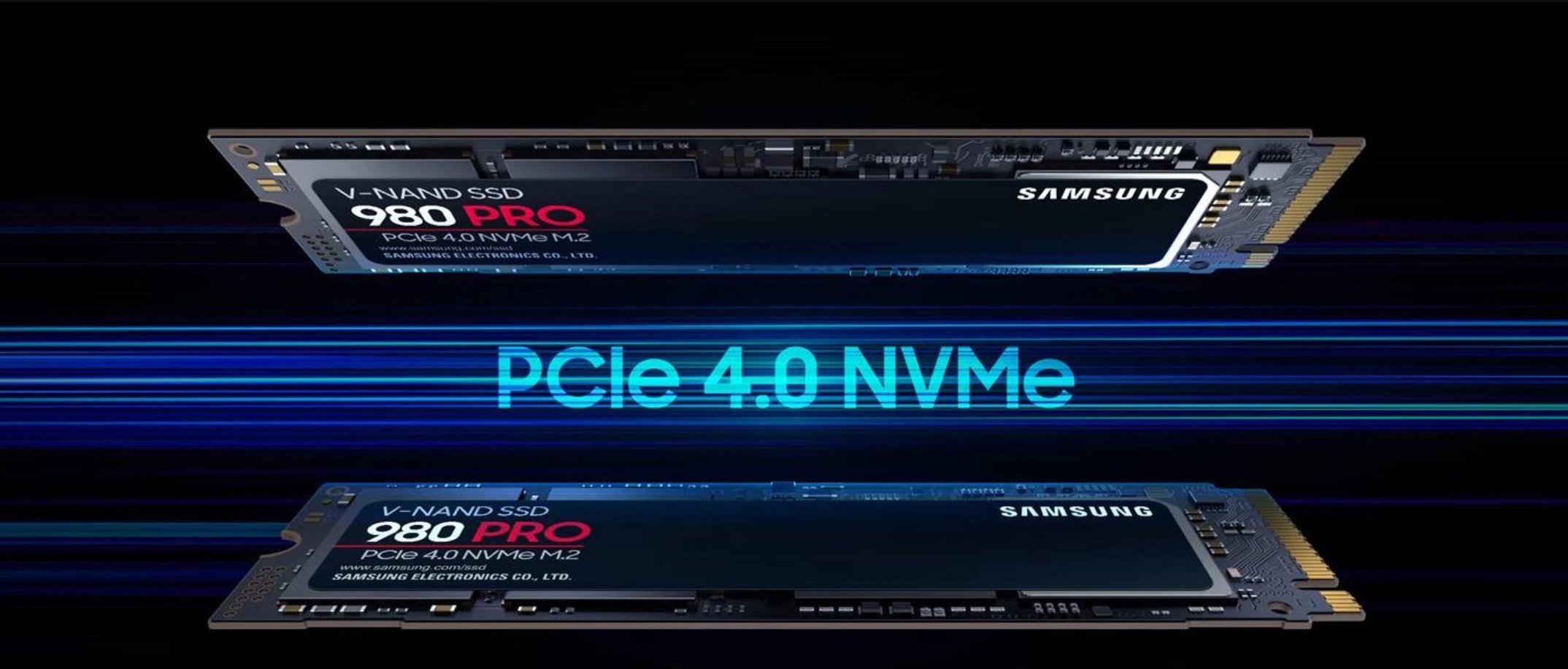
Samsung 980 PRO NVMe PCIe 4.0 SSD – Image Source: Samsung
It usually is a good idea to get a larger HDD to be able to periodically backup your Data in case your main Discs break down for unforeseeable reasons. As they tend to do in the middle of the most important Project.
With a larger Hard Drive, you can have your inactive Projects Archived and only have your Active Projects on the fast Drives, saving space on your fast drives.
About PCI-E-Lanes
This section is a bit more advanced, but I get this question often enough that I want to explain it. Feel free to skip this part.
Here's the Question: If mainstream CPUs such as an Intel 10900K, or AMD Ryzen 5900X only offer 16 PCIe-Lanes, how can you use NVME SSDs (that already need 4 PCIe-lanes) or SATA Drives, if your GPU already uses up all of the 16 PCIe-Lanes to the CPU?
Answer: While the CPU-GPU PCIe-Lane interconnect is 16 PCIe Lanes wide, the Chipset itself can create 24 additional PCIe Lanes if required (on the Z370/Z390 Chipset).
The chipset lanes are connected to the CPU through a DMI link that's only 4 PCIe lanes wide (which is roughly 4GB/s).
There could be a bottleneck in the unlikely scenario that you continuously copy huge amounts of data (like 50GB) from one of your NVMe SSDs to your second NVMe SSD and if your NVMe SSD can read and write faster than 2GB/s.
While that type of sequential read/write is possible (with the 970 EVO it is), it's extremely rare that you'll continuously be reading and writing sequentially for files that are of such size. If anything, you'll be reading/writing randomly and on much smaller files.
Everything except for the RAM and the GPU is connected to those 24 chipset PCIe lanes, which are themselves connected to the CPU through the DMI link that's 4 PCIe lanes wide. This includes LAN, USB, and everything else you plug into the motherboard.
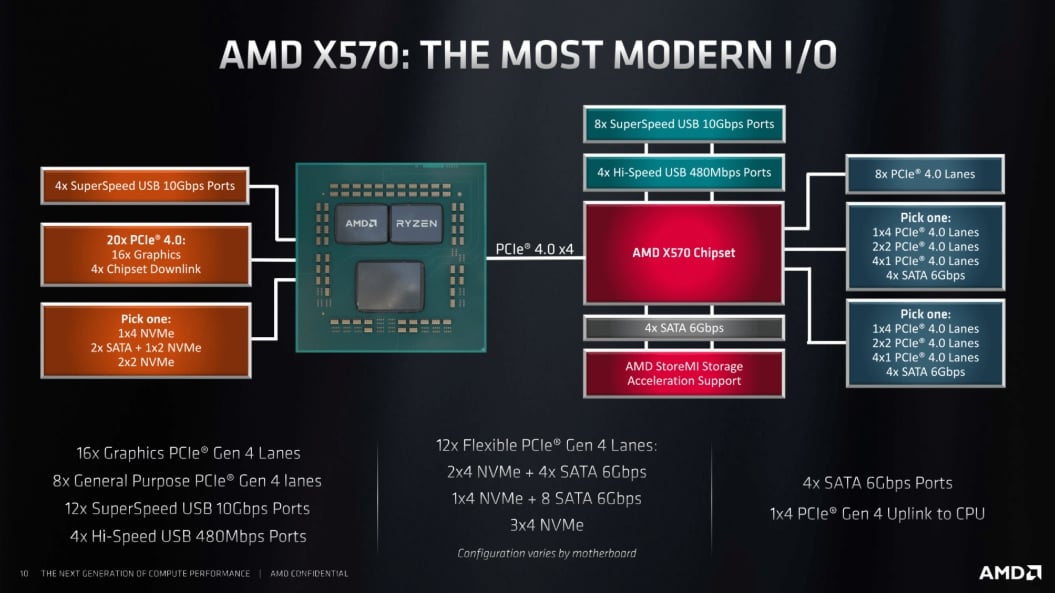
Image-Credit: AMD
The PCIe lanes from the chipset to the CPU are not used from the moment you plug in a new component. Instead, think of these PCIe lanes like highway tunnels: they're always there and let traffic through if it has to .
So you can attach up to 24 PCIe lanes worth of components to the chipset (SATA SSDs, HDDs, USBs, Ethernet cables, etc…) but they will only connect to the CPU and use Bandwidth when needed.
If you use all those components at maximum speed at the same time, then you would bottleneck. In such a scenario, you would need to turn towards the HEDT platform (such as the LGA 2066 or TR4) and not mainstream (1151, AM4).
There's quite some depth to PCIe-Lane technology that you can use to your advantage and improve your PC's performance. Be sure to go through our Guide to PCIe-Lanes, especially if you're looking at driving multiple GPUs or a lot of storage devices.
Best Monitor for 3D Modeling and Rendering
It's usually better to go for a monitor with an IPS panel instead of a TN panel . IPS display panels have better color and better contrast.
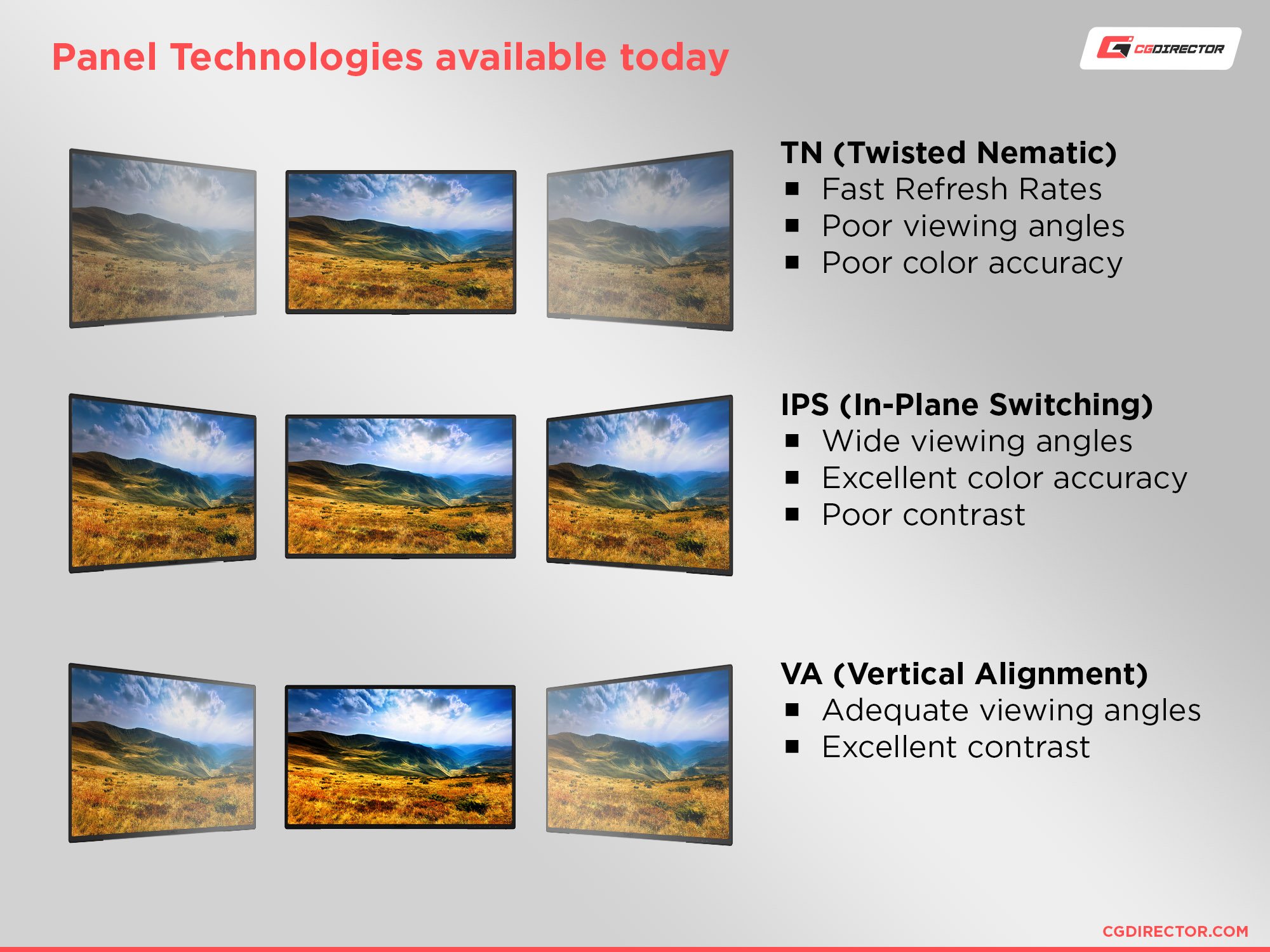
If you'll spend many hours a day staring at your monitor, you'll want a non-glare (matte) monitor . This will avoid hard reflections that could otherwise distract you.
You also want at least a Full HD 1920×1080 monitor that nicely fits the viewport and all your software. You might even want to consider higher-resolution monitors with a 2560×1440 or even a 4K (3840×2160) resolution , so you can fit more of your footage, references, and software windows.
This is particularly true if you're working on 4K advertising and films, or on hi-res images.
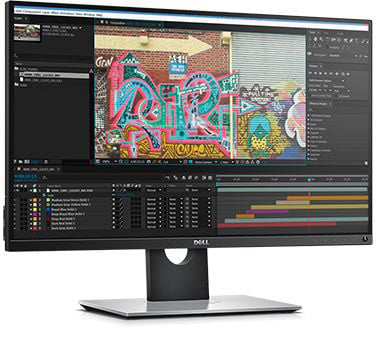
Image-Source: Dell
I've had great experiences working on Dell IPS monitors, such as the Dell UP2716d, but you might prefer a different brand.
How many Monitors do you use?
-
Two Monitors 57%, 5085 votes
5085 votes 57%
5085 votes - 57% of all votes
-
Just one Monitor 32%, 2869 votes
2869 votes 32%
2869 votes - 32% of all votes
-
Three Monitors 10%, 869 votes
869 votes 10%
869 votes - 10% of all votes
-
More than 3 Monitors 2%, 169 votes
169 votes 2%
169 votes - 2% of all votes
Total Votes: 8992
14. May, 2020
×
You or your IP had already vote.
Check out this in-depth Guide to buying the best Monitors for visually demanding work, which has all the information you need for getting the best Monitor for your specific kind of work.
Best Power Supply (PSU) for 3D Modeling and Rendering
While an expensive PSU won't increase your performance, it's wise to get more than enough wattage.
Usually, you'll want around 400-500 Watt for a regular build, with an additional 250W for every additional GPU .
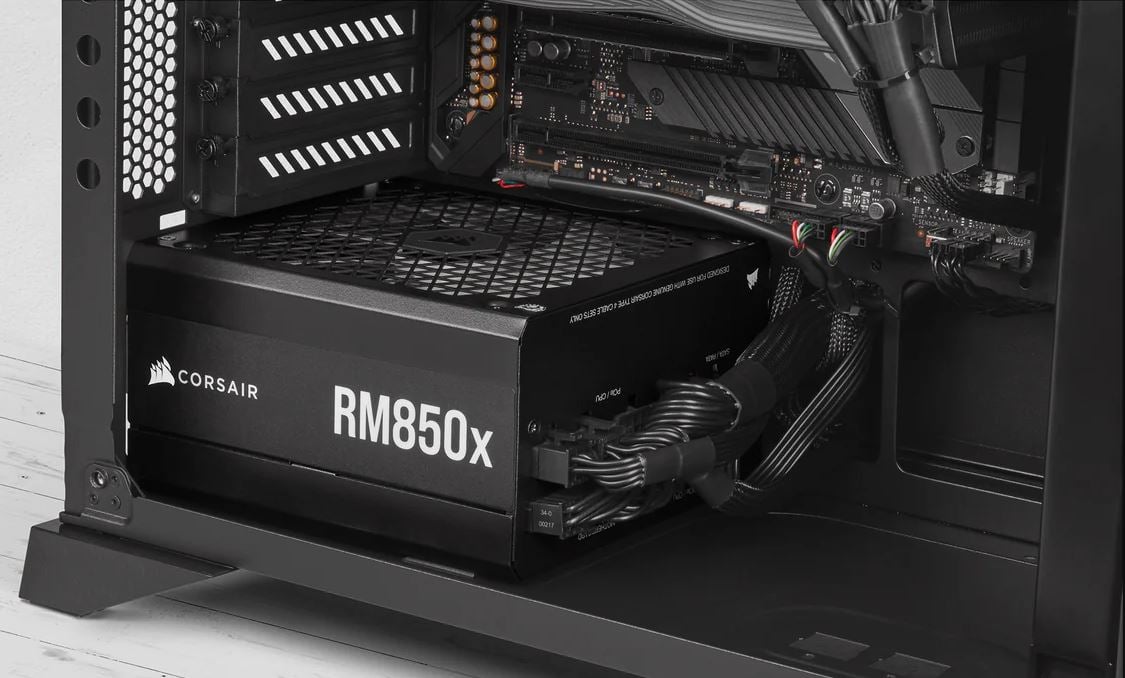
Corsair RM850x PSU inside a PC Case – Image-Source: Corsair
Good PSU brands are Corsair, Seasonic, and beQuiet.
Here's a PSU calculator that will tell you how many watts your PSU will need depending on the hardware you choose.
Another thing you should consider is to get a Modular PSU instead of a regular PSU. Modular PSU's let you detach any cables you don't need from it, which helps in freeing up the inside of the case and improves airflow.
Build your own Computer!
The best computer for 3D modeling and rendering is a computer that's fast, makes you spend less time on it, avoids you wanting to punch through your monitor, and shouldn't cost you an arm and a leg.
I get tremendous joy from building my own computers for 3D modeling, rendering, and many other use cases.
If you don't build your own PCs yet, I'm sure you'll learn to love it too .
Do you assemble your PC yourself or buy Pre-Built?
-
I assemble myself 66%, 3187 votes
3187 votes 66%
3187 votes - 66% of all votes
-
I buy Pre-Built / Let others assemble my PC 34%, 1611 votes
1611 votes 34%
1611 votes - 34% of all votes
Total Votes: 4798
14. May, 2020
×
You or your IP had already vote.
Building your own computer teaches you the inner working of the various hardware components while allowing you to gradually upgrade parts if so required and helping you find potential problems more easily.
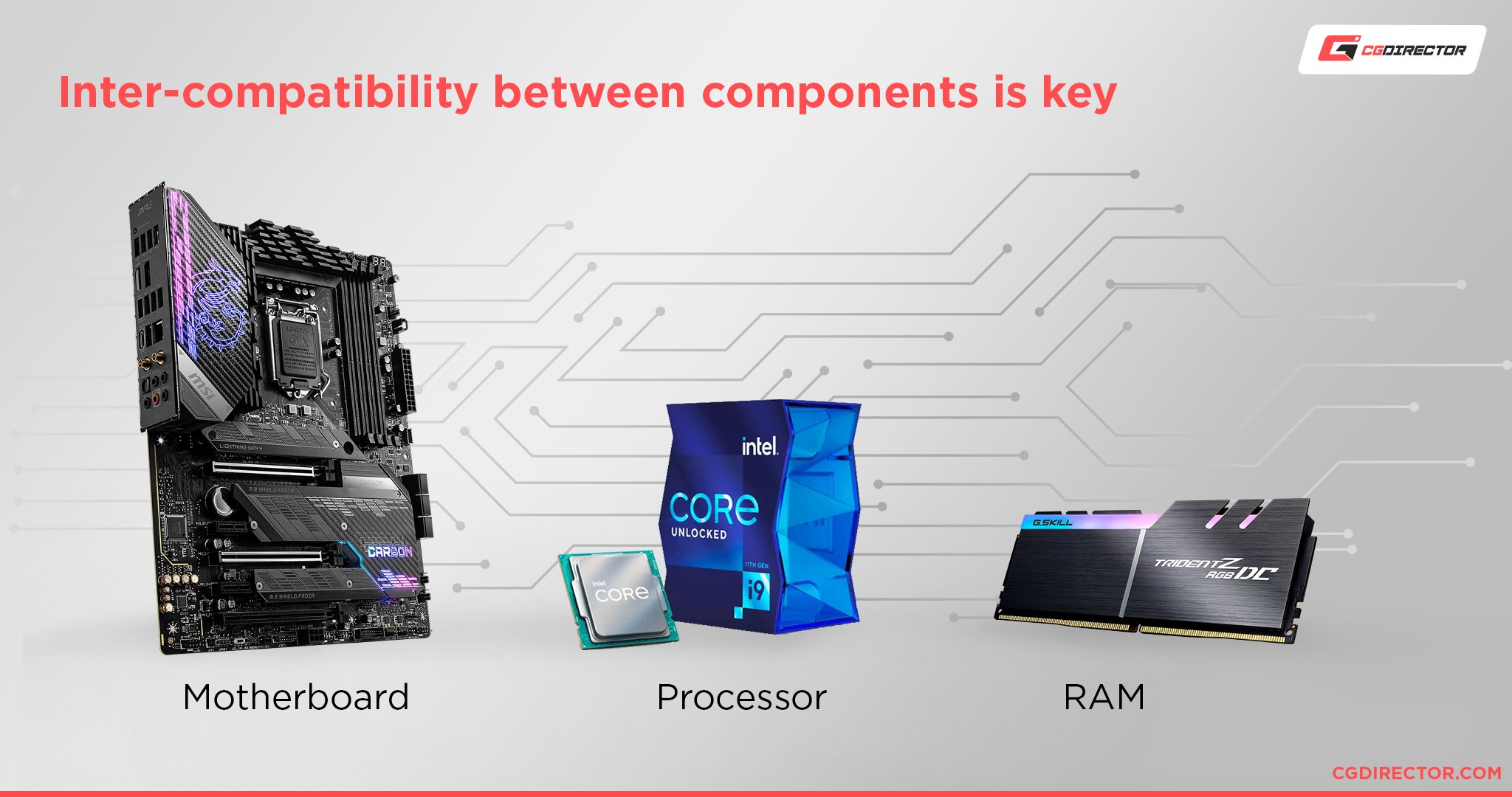
But the best part? It's a lot cheaper than buying pre-configured computers, and it only takes an hour or two to assemble!
If you want to learn how to assemble a PC and how a computer actually works , I have an excellent book for you. It blew my mind a few years ago. You might've read it already, but for those of you who haven't: prepare to be leveled up – this makes a great gift for a tech-enthusiast as well:
But How Do It Know – J. Clark Scott
I can't stress it enough: assembling your own computer is not difficult . You more or less just plug different parts needed to build a PC into one another and tighten some screws. The hardest part seems to be adding a bit of thermal paste to the CPU. That's it!
Here's a nice tutorial video for you to follow along as you build:
Whew! That was quite a lot of theory. Let's actually take a look at some functional PC builds.
Here are some Pre-Selected Builds in different Price Tiers:
Best full PC-Build Recommendations at different Price points
Best Computer for 3D Modeling and Rendering, AMD at roughly ~900$
Some Build notes:
This lower-budget Build can be made even cheaper if you use the CPU Cooler that comes with the CPU. You can downgrade the CPU to a 3600 or 3300X if you need to save more money or downgrade the NVMe SSD to a regular SATA SSD such as the Samsung 870 QVO.
If you want to increase performance and have some extra cash on hand, consider buying a 3700X or 5600X CPU. A 1660 Super or 1660 Ti could get you some additional GPU performance.
Best Computer for 3D Modeling and Rendering, AMD at roughly ~1500$
Some Build notes:
This is a basic AMD build that you can begin with. The Case is professional, minimalistic, and quiet and has great airflow.
The AMD Ryzen 5 5600X comes with excellent single-core performance that will make your viewports extremely responsive. We often recommend an x570 Motherboard in conjunction with a 5xxx Series AMD Ryzen CPU, but you could get away with a B450 or B550 Motherboard if you are under budget constraints. Be sure to take a look at this article on the best motherboards for Ryzen CPUs, to see which one exactly you will need.
The Nvidia RTX 3070 packs great performance in CUDA and OptiX related workloads such as GPU rendering and is a great buy at this price-tier.
Best Computer for 3D Modeling and Rendering, AMD at roughly ~2500$
Some Build notes:
Another Build with an AMD CPU. We used to have an Intel-Build at this price range, but right now, AMD is leading the CPU competition across the board.
The Ryzen 9 5950X is in a league of its own. Great Single-Core and Multi-Core performance make this the best CPU for active workloads and viewport performance you can buy right now. The 16 Cores offer good performance even for CPU-rendering complex scenes.
The Nvidia RTX 3080 comes with 8704 CUDA Cores which will accelerate your work in GPU Render Engines such as Redshift, Octane, or Vray. Other Apps and plugins that support CUDA / OptiX such as the Adobe Creative Cloud, benefit from these kinds of GPUs too.
You can upgrade this PC with more RAM, bringing it to 64GB, which would be a solid upgrade for a true 3D-Animation and Rendering workstation.
Although the Samsung 980 PRO has great performance in all kinds of read/write workloads, you could save some money here and get an older Samsung 970 EVO Plus or something like an Adata XPG pcie4 SSD.
Best Computer for CPU Rendering, AMD at roughly ~5000$
This is an excellent Build that leans towards CPU Rendering Performance and slightly less towards active-working performance in tasks such as 3D Modeling or Animating.
Some notes on this build:
As this build is focused on CPU Rendering, the other parts such as storage and GPU are proportionally low-end compared to the 64-Core Threadripper CPU. This build has an absolutely fantastic CPU Rendering Performance.
128GB of RAM is a lot. It should be more than enough for all kinds of complex projects. You can save some money by downgrading to 64GB or even 32GB though if your scenes are rather simple.
Best Computer (Render node) for GPU Rendering, AMD at roughly ~7100$
This is an excellent Build that will bring you the maximum plug & play GPU Rendering Performance (on a single Consumer Mainboard) combined with an excellent CPU for good Workstation performance. But it comes at a steep price.
Some notes on this Build:
4 GPUs need a Motherboard with 4 PCIe Slots that are spaced far enough from each other to allow for 4 dual-Slot GPUs. This is possible with the Gigabyte X399 Designare EX Motherboard.
At ~$1,200 each, RTX 2080TIs are expensive. If you're okay with slightly slower performance, but want to save a decent chunk of money, I recommend going with 4x RTX 2070 , as these come in at around $550 each. You'll only have 8GBs of VRAM per card, but the GPU rendering performance/price is much better.
The Case is big. It has room for 8 single-slot (or 4 dual-slot) Cards. The Power Supply should provide at least 1250W and I added some headroom here with the excellent 1600W Corsair Titanium Power Supply.
Threadripper CPUs are excellent for multi-GPU setups, as these CPUs have 64 PCIe-Lanes to drive all of those GPUs in 16x and 8x Mode.
– All of these builds will of course need a Keyboard, Mouse, Monitor, and Operating System to be complete, but I'll let you figure those out on your own. –
Custom PC-Builder
If you want to get the best parts within your budget you should definitely have a look at the Web-Based PC-Builder Tool that I've created.
Select the main purpose that you'll use the computer for and adjust your budget to create the perfect PC with part recommendations that will fit within your budget.
Be sure to check it out and please feel free to send feedback my way!
CGDirector PC-Builder Tool
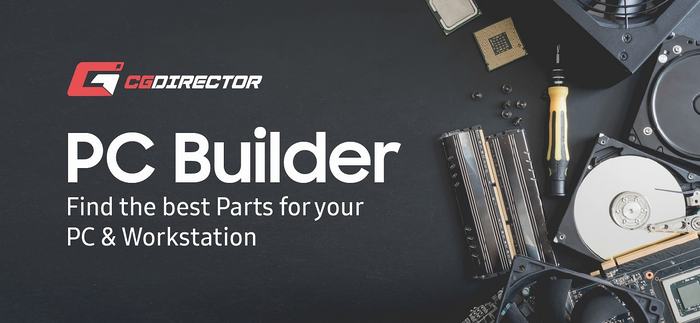
If you are not quite sure yet what general kind of Computer, Desktop, Workstation or Laptop you need and you are still looking for some beginner's help, check out this article on finding exactly what kind of Computer you need.
Want to be more mobile?
Just a quick reminder for anyone who would like to be more mobile instead of working on a stationary Desktop PC or Workstation.
I have written an article about what's important in a Laptop for 3D Modeling and Rendering and Laptop for Animation if that's a direction that interests you too. Go check it out!
For CPU rendering, this article on the best CPU for rendering can help you out.
Over to you
What kind of Computer or Workstation are you building? Let us know in the comments or ask our experts anything about PC-Building in our forum.
Custom Workstation For 3d Design
Source: https://www.cgdirector.com/best-computer-3d-modeling-rendering/
Posted by: craighatiagoorah.blogspot.com

0 Response to "Custom Workstation For 3d Design"
Post a Comment